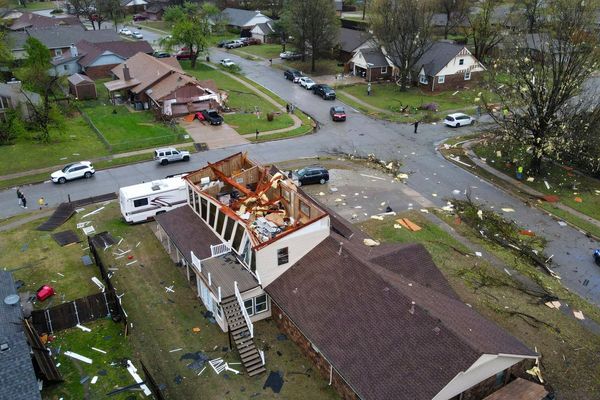
Jake Lieb drives his John Deere two-seater around his property and across the shallow Camp Creek. The waterway cuts back and forth through miles of farm fields until it reaches the Sangamon River and eventually pours into Lake Decatur 32 miles away — the man-made source of water for 200,000 people.
These are troubled waters. The city of Decatur paid $100 million in 2021 to dredge so much polluted sediment from the lake that it could have filled the Willis Tower seven times.
And much of it was from farms like Lieb’s, the soil swept away by increasingly heavy and unpredictable rains. When the downpours come, they funnel topsoil and costly fertilizer into the creek, the river and, miles downstream, the lake.
The problem doesn’t end there. This agricultural runoff, occurring in watersheds all over Illinois, eventually ends up in the Gulf of Mexico, where it contributes to an oxygen-starved dead zone that threatens fish and other sea life.
Lieb wants his remaining soil to stay where it is, and he’s among a small but growing percentage of Illinois farmers experimenting with how. Well before the pileup in the lake and before dust storms blanketed Interstate 55 in central Illinois, leading to eight fatalities, Lieb was rolling out soil conservation projects.
“I got to save something for my family, you know what I mean?” says Lieb, 41, who has two young sons.
Now, the city of Decatur, the federal government and the Illinois Farm Bureau have pledged to assist and pay farmers to reduce water and wind erosion.

The extra money is good news for Lieb, who is an early adopter and experimenter. He’s not alone, but he is surrounded by many farmers who stick to the tried-and-true methods of heavy plowing and bare winter fields to grow crops and pay the bills.
Many are resistant to change despite increasing bouts of severe weather including this year’s spring drought and torrential rains that followed and the threat to corn and soybean yields because extreme weather means more erosion and runoff.
Lieb has learned that farming profitably with a conservation mindset requires time, money, trial and error and a long-term perspective was nurtured by parenthood.
“I didn’t know what the hell I was doing when I started,” says Lieb, whose family has been farming in central Illinois for five generations.

Farms don’t much look like they used to. The 72,000 Illinois farms in operation today, covering 75% of the state’s land mass, are much bigger than farms of old. The number of Illinois farms has shrunk by half over the past 60 years, as advances in machinery and technology produced more crops per acre, and children left farms for jobs in cities. By acreage, Lieb Farms slots into the biggest one-third.
Still, the vast majority are considered family farms. But these operators don’t own all of the land they tend. Much of it is owned by absentee landlords including investors, family trusts and other non-farmers, with prime ground going for as much as $20,000 an acre.
Two of the biggest Illinois farmland owners are the Mormon Church, at No. 1, and Microsoft founder Bill Gates.

Lieb owns a good chunk of his corn and soybean farm and pays “cash rent” on the rest. Bumping through the woods as he motors around the border of his family’s land, Lieb points out where he has been clearing invasive honeysuckle and other brush from a 30-acre woodland floodplain bordering the creek. He weaves around the corrugated plastic drainpipe he placed throughout the woods to protect the native pecan, oak and hickory trees he planted, just as his father used to do.
In another sensitive area of hilly ground, Lieb took four acres out of crop rotation, at no small cost to his revenue, and installed a grass waterway that allows heavy rains to run down an incline without carrying away soil. On a much larger scale, Lieb plants cover crops — mostly winter rye — to keep a live root in the ground all winter.
“I got to save something for my family, you know what I mean?” he says.
For years, he has reduced plowing on about half his acreage. And he recently built an erosion-blocking terrace funded in part by a federal program.
Lieb came to be a proponent and practitioner of conservation techniques through a combination of natural curiosity, wanting to protect the land for his two young boys and the influence of a key person in his life — his grandfather.
Sitting in his shop, waiting for a John Deere repairman, he talks about how his then-88-year-old grandfather was part of a group trying to protect the aquifer from a proposed landfill. They went to a few meetings together. On the way home late one night, he noticed how tired his grandfather looked.
“One time, I said, ‘Grandpa, why you doing this?’ And he goes: ‘For you.’ I’ll never forget that. I’ll never forget the look on his face. I’ll never forget the way he said it. He just said ‘You.’ ”

Only about one-fifth of Lieb’s farmed acreage is planted with cover crops. He says that some of the flat, black dirt doesn’t need them, and the absentee landowners he farms for don’t always have the same incentives.
In 2020, crop prices were high, and an Ohio-based investor wanted to replace a two-acre windbreak with row crops to earn an extra few thousand dollars. Lieb made a case to keep it but ultimately gave in to keep the contract.
“That was very disheartening,” Lieb says. “We farm for people who live out of state. All they see is the check they get in the mail.

“Now, I’ve got kids, and I look at them, and it motivates me,” he says. “Is it worth the money to put the waterway in? Is it worth the money to not take that hedgerow out, the money we could gain from it? One look at my kids, and I know what to do.”

Growing up in Macon in central Illinois, Michelle Carr wanted to farm since she was a kid. During high school summers, she baled hay and worked two other jobs — at a Farm & Fleet store and on a Christmas tree farm. Her parents encouraged her to go to college. So she got a degree in plant and soil science at Southern Illinois University.
She worried that, as a woman, she wouldn’t get a chance to run the family farm. So she got a job as a crop insurance adjuster. But last spring, with the support and tutelage of her 55-year-old uncle, she took over her family’s farm and planted her first crops as the boss.
Then, for a month and a half, it barely rained.
Fortunately, she’d gotten the crops in early. When the rains finally came, ending a statewide drought, her corn and beans emerged nearly unscathed.
At 35, Carr stands out in a state in which the average age of farmers is 58. She also is one of a small number of women heading a sizable farm — over 1,000 acres. A mother, she listens to her uncle’s voice of experience and uses what she learned in college to help puzzle out the intricacies of soil conservation.

Tired of seeing the intense rains create gullies and washouts in her fields and aware of the growing threat of climate change, she planted about one-third of her acreage in cover crops. Like many farmers, she has dramatically reduced costly fertilizer use with advanced technology that crunches soil data and feeds it into a GPS mapping system. She has also planted a pollinator garden on a few acres of less productive farmland.
“We only have so much soil,” Carr says. “We can’t get more of it.”

But high costs and the need for special equipment have slowed her down.
“I try to do my part to help cut back, to make it better,” Carr says. “One day, I would like to have everything in a cover crop.”
Still, measures such as cover-cropping can be costly, time-consuming and sometimes risky — which is why some farmers aren’t eager to take them on. Cover crops can reduce yields in the short run, studies have shown. In the Midwest, cover crop usage has tripled in the past decade but is still minuscule at 7%.
There’s also the matter of delayed results. How effective these efforts will be and whether they will be big enough and fast enough to make a difference won’t be known for years. A 2019 study by the Illinois Environmental Protection Agency found that fertilizer runoff was still rising steadily four years after the state set a goal to reduce it. Now, a new National Climate Assessment predicts dire consequences on Midwestern corn yields unless humans adapt fast.

Forcing farmers to change has produced a political backlash in Europe and isn’t on the table in the United States, where, instead, incentives are offered. To overcome farmer resistance to new techniques — including a belief by some that human-driven climate change is a “hoax” — conservation groups hope farmers like Lieb and Carr can be examples of how to “make hay” and conserve resources at the same time.
“We are trying to hit that sweet spot, melding conservation goals and agronomic goals and still have farmers make a profit,” says Megan Baskerville, the Illinois agriculture program director for The Nature Conservancy. “Farmers need to see the benefits, see the positives on the farm.”
The U.S. Department of Agriculture provides incentives to try to entice farmers to adopt conservation measures through programs that can be a headache to apply and qualify for. In the past, the average farmer’s odds of getting a grant weren’t great. More applications are submitted than are funded, and the money typically ran out about halfway through a budget year.
Even when money is delivered, conservation advocates say, the USDA spends just a tiny percentage of its budget on such efforts and what it offers isn’t always well-targeted.
But the funding shortage should change with the passage of the federal Inflation Reduction Act, which promises an unprecedented $20 billion over five years for farm conservation, the biggest investment since such programs began almost a century ago, following the Dust Bowl catastrophe.
“There’s been no other time when the opportunity is this large,” says Baskerville, who worked on the Decatur watershed project.
The Illinois Farm Bureau, which has 75,000 members, has gotten incentives approved by the Illinois Legislature. Farmers who use cover crops get a discount on farm insurance policies of $5 per planted acre. A fee on fertilizer pays for research and education. The bureau also holds “field days” around the state to explain the latest conservation practices.
What are known as “carbon credits” are creating marriages of convenience between farmers and large corporations such as Chicago-based Archer-Daniels-Midland Company and New York-based PepsiCo, which have made environmental pledges. The companies pay farmers for conservation measures like cover crops and no-till planting and receive a credit for the carbon that, as a result, didn’t end up being released into the atmosphere — in essence reducing their own carbon footprint through a trade.
Lieb is one of a small number of farmers to so far have signed one of these contracts — with a large food manufacturer he declines to name. He says he gets $15 to $20 an acre for cover crops and reduced tillage, not much, he says, but it helps defray his costs.
“A lot of corporations are trying to get their names on sustainable ag,” Lieb says.
Along with the billions in new federal conservation money, the embryonic carbon-credit market could help encourage cover crop planting and less plowing.
The would help keep dust off highways, algae out of waterways and the soil where it belongs.
“It’s about leaving something for tomorrow,” Lieb says. “It’s only ours to borrow.”







